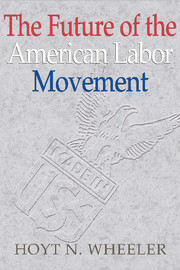Book contents
- Frontmatter
- Contents
- Foreword
- Introduction by Lynn R. Williams
- 1 A Future for the American Labor Movement?
- 2 Industrial Relations in a Time of Change
- 3 A Survey of American Union Strategies
- 4 The Old Reformist Unionism: The Noble Order of the Knights of Labor
- 5 The New Reformist Unionism: CAFE
- 6 A New Version of an Old Reformist Strategy: Employee Ownership
- 7 Social Democratic Unionism in Action: Strategies of European Trade Unions
- 8 A New Twist and TURN on Social Democratic Unionism: Unions and Regional Economic Development
- 9 A Labor Movement for the Twenty-First Century
- Appendix: Interview with John J. Sweeney, President, AFL-CIO
- References
- Index
Appendix: Interview with John J. Sweeney, President, AFL-CIO
Published online by Cambridge University Press: 06 July 2010
- Frontmatter
- Contents
- Foreword
- Introduction by Lynn R. Williams
- 1 A Future for the American Labor Movement?
- 2 Industrial Relations in a Time of Change
- 3 A Survey of American Union Strategies
- 4 The Old Reformist Unionism: The Noble Order of the Knights of Labor
- 5 The New Reformist Unionism: CAFE
- 6 A New Version of an Old Reformist Strategy: Employee Ownership
- 7 Social Democratic Unionism in Action: Strategies of European Trade Unions
- 8 A New Twist and TURN on Social Democratic Unionism: Unions and Regional Economic Development
- 9 A Labor Movement for the Twenty-First Century
- Appendix: Interview with John J. Sweeney, President, AFL-CIO
- References
- Index
Summary
Question: What is the current state of the labor movement in the United States, how did we get there, and what are the strategies that will work best in the future?
Answer: We're changing. In 1994 we didn't do too well in the Congressional elections. Newt Gingrich scared the hell out of us. The union leadership started talking about how to change. This led to my election. I don't blame the past leadership. I had a good record at the SEIU [Service Employees International Union] of growth from organizing activities. This wasn't about Lane Kirkland or Tom Donahue. They were great leaders who spent a lifetime in the labor movement. But we had to try new approaches, to put resources into organizing, try new methods, and take risks.
We wanted to arrest the decline, not so much in numbers, but we wanted to be more effective politically. We needed to reach out to our grass roots. Polling and focus groups showed that our members wanted to be more involved. They did not want a group in Washington to dominate. They wanted to select candidates and hold them accountable.
In 1996 we picked up House [of Representatives] seats. In 1998 we did the same. 2000 was our best year in terms of union turnout, but not enough to win the House, Senate, or White House, although we do think that Al Gore won. We did improve the perception of the labor movement as to how our members and the public felt.
- Type
- Chapter
- Information
- The Future of the American Labor Movement , pp. 217 - 220Publisher: Cambridge University PressPrint publication year: 2002



